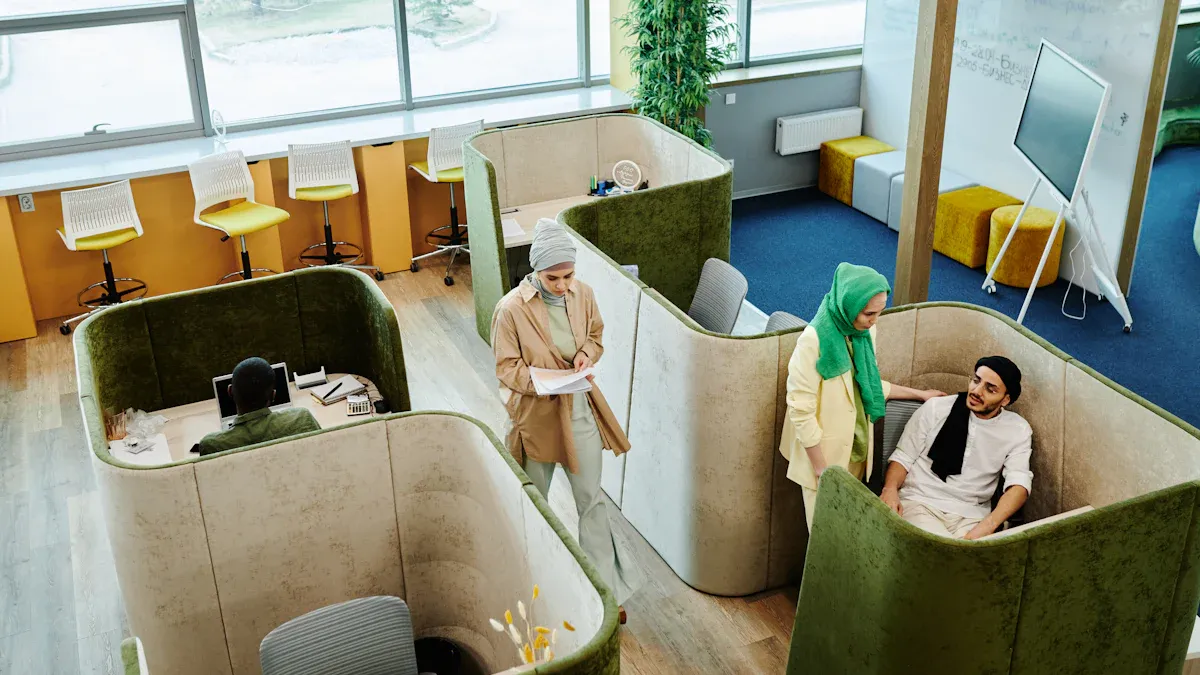
An office booth pod shapes a productive environment by reducing distractions and supporting focused work. Employees using open office pods report improved concentration and less stress. A portable office booth or acoustic sound booth often leads to fewer errors, higher daily output, and better work-life balance for teams.
Identify Your Office Booth Pod Needs
Team Size and Usage
Selecting the right pod begins with understanding team size and how employees will use the space. Offices vary in their needs, from solo phone booths to large meeting pods. Teams often require a mix of private and collaborative spaces. Pods come in different sizes to support these needs:
| Pod Type | Capacity | Features and Use Cases |
|---|---|---|
| Small Phone Booths | 1 person | Private, soundproof booths for confidential phone or video calls; mobile options for easy relocation. |
| Medium Work Pods | 1 to 4 people | Enclosed, soundproof pods for focused work or small team meetings; configurable with desks and seating. |
| Large Meeting Pods | 2 to 8+ people | Spacious, modular meeting rooms with acoustic treatment; customizable with presentation equipment. |
For small offices, placing booths in underutilized corners maximizes space. Midsize offices benefit from arranging pods near departments to encourage collaboration. Large offices distribute pods across floors, considering foot traffic and natural light. A general rule suggests one solo pod and one team pod per department group of up to twelve employees. Teams not working in neighborhoods often use one phone booth per five employees and one meeting booth per ten employees.
Pods support a balanced workspace ecosystem. Modular and reconfigurable designs allow for quick adaptation as teams grow or change. Acoustic materials and glass panels provide privacy and noise control, supporting both focused work and group collaboration.
Space Constraints and Layout
Modern offices face unique space challenges. Ensuring the booth fits the allocated area without feeling cramped remains essential. Deciding whether the booth serves as a centerpiece or fits into a corner shapes the overall office flow. Integrating the booth design seamlessly into the environment enhances both aesthetics and function.
- Position pods near common work areas but away from busy corridors to maximize accessibility and minimize disruption.
- Consider traffic flow to prevent congestion around booths.
- Balance open spaces with private pods to accommodate diverse working styles.
- Leverage natural light and thoughtful spatial arrangements to boost office efficiency.
Careful planning improves pod placement. Place pods near power outlets to avoid clutter from extension cords. Maximize natural light exposure, which research from UCLA links to improved mood and productivity. Maintain minimalism inside pods by removing unnecessary items. Modular pods create clear boundaries between work and leisure areas, making the space feel larger and less cluttered. Stagger pod doors when installing multiple pods to reduce corridor congestion and visual overlap.
Tip: Setting up a modular pod in a corner angled toward a window allows natural light to brighten the workspace and creates an illusion of a larger room.
Frequency and Type of Use
How often employees use the pod and for what purpose shapes the selection process. Pods serve many roles, from quiet phone calls to collaborative brainstorming sessions. Organizations use pods as cost-effective alternatives to permanent renovations. They scale and move easily to fit changing layouts. Pods support conference calls, client meetings, and focused work.
- Individual pods suit phone calls, quick meetings, or personal recharge.
- Team pods accommodate two to six people for collaborative work.
- Users seek balanced acoustics, airflow, power access, and appropriate lighting for comfort and usability.
The frequency of use also impacts cleaning and maintenance schedules. High-traffic pods require weekly or fortnightly cleaning and monthly maintenance. Moderate-use pods need bi-weekly to monthly cleaning and quarterly maintenance. Low-use pods can be cleaned monthly and maintained twice a year.
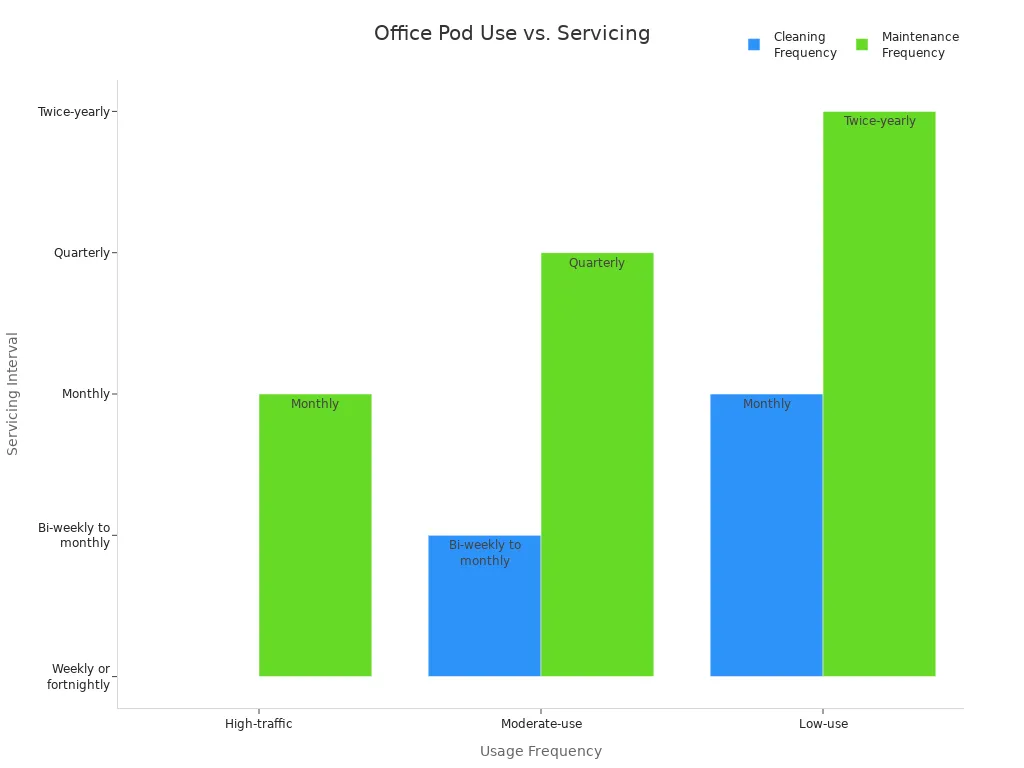
Sound insulation is critical for pods with high usage to maintain privacy and reduce noise. Ventilation, lighting, and power outlets become essential features for intensive use. Modular designs offer flexibility, making them suitable for varying usage frequencies. Durable, high-quality materials ensure longevity, especially for pods expected to endure frequent use. Ergonomic furniture and customizable features maintain comfort and productivity.
Office Booth Pod Key Features
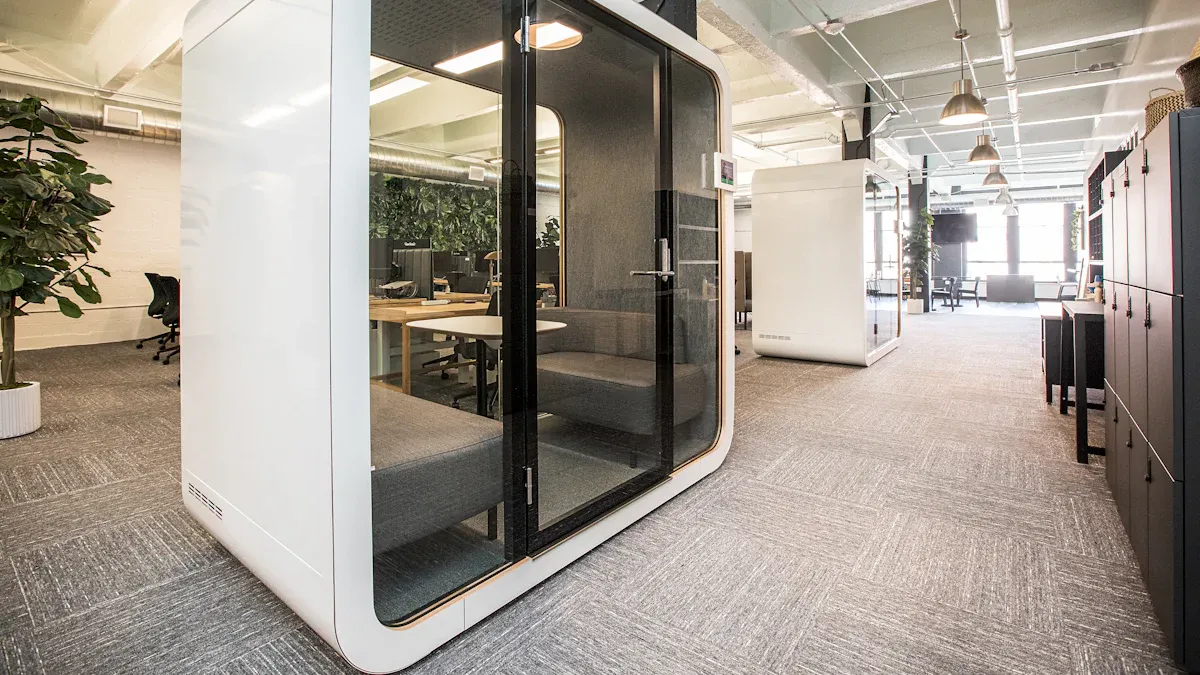
Soundproofing and Acoustic Performance
Soundproofing stands as a core feature in any modern office booth pod. Effective sound isolation allows employees to focus, make confidential calls, and hold meetings without distractions from the surrounding office. Leading pods, such as Framery One™, ROOM Phone Booth, and Zenbooth Solo, achieve a sound insulation level of 30 dB, which meets the Class A soundproofing rating under ISO 23351-1. This level of performance ensures privacy and reduces noise in open-plan offices.
A standard soundproof office phone booth should have a Sound Transmission Class (STC) rating between 35 and 40. This range blocks most speech and typical office noise, creating a quiet environment for users. Higher STC ratings, above 40, provide even greater sound isolation, suitable for especially noisy workplaces. Prodec pods, for example, are tested to isolate sound by approximately 35±5 dB, making them ideal for busy office settings.
| Model | Sound Insulation (dB) | Key Acoustic Features | Additional Features |
|---|---|---|---|
| Framery One™ | 30 | Aluminum alloy frame, acoustic panels, tempered glass | Built-in desks, touchscreen control, ventilation system |
| ROOM Phone Booth | 30 | Similar soundproof materials | Built-in desk, two power outlets, LED light |
| Zenbooth Solo | 30 | Effective soundproofing materials | Height-adjustable desk, dimmable lighting |
| Thinktanks 1 Person | 25.7 | Acoustic panels, tempered glass | Motion sensor, high-efficiency ventilation |
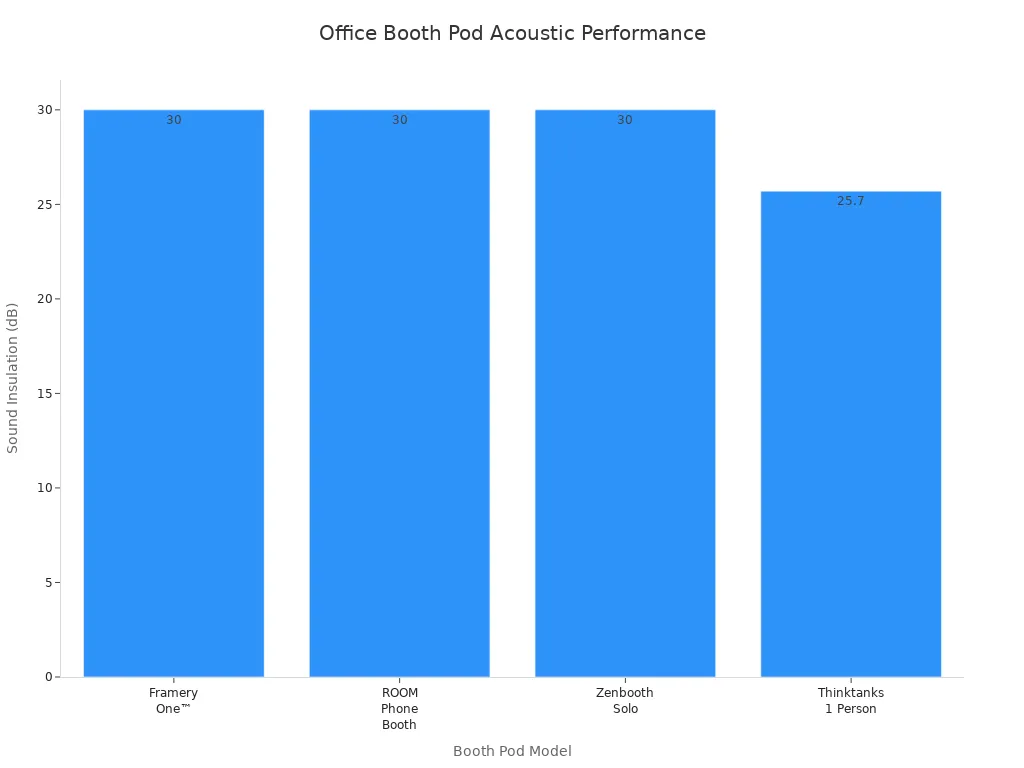
To accurately assess acoustic performance, experts recommend testing pods in real office conditions. This includes speaking inside the pod and listening outside to check for sound leakage. High-quality pods balance external and internal sound isolation, ensuring privacy while allowing users to hear important external sounds for safety. Internal reverberation time should remain low, between 0.1 and 0.3 seconds, to improve sound clarity during calls. Always evaluate acoustic performance based on the complete pod, not just individual components.
Tip: Choose a pod with a high STC rating and low internal reverberation for the best acoustic experience.
Privacy and Visual Barriers
Privacy in an office booth pod depends on both soundproofing and visual barriers. Acoustic panels and sound-absorbing materials keep conversations private and reduce noise from the open office. The “room within a room” design concept enhances sound isolation and supports confidential discussions.
Visual barriers play a key role in minimizing distractions. They create secluded environments that help users concentrate on tasks. Unlike traditional cubicles, fully enclosed pods shield users from both visual and auditory interruptions. This design fosters a private retreat for focused work, private calls, or sensitive meetings.
- Visual barriers reduce visual interruptions and enable better concentration.
- The design balances privacy with a connection to the larger office, preventing feelings of isolation.
- Ergonomic and aesthetic factors improve comfort and reduce stress.
Pods often include features such as motion-activated lighting, integrated power outlets, and ergonomic interior fittings. These elements support productivity and comfort while maintaining privacy. High-quality pods, like the Silent Room Phone Booth and Uniq Phone Booth, combine these features to enhance well-being in open office environments.
Ventilation and Air Quality
Proper ventilation ensures comfort and health inside an office booth pod. Modern pods use a mix of natural and mechanical ventilation systems. Adjustable airflow controls let users customize ventilation for their needs. Many pods connect to existing HVAC systems, which helps maintain consistent air quality and energy efficiency.
- Natural ventilation uses windows and vents to circulate outdoor air, suitable for low-occupancy pods.
- Mechanical systems, such as supply-only, exhaust-only, and balanced ventilation, actively manage airflow for higher occupancy or limited natural airflow.
- Heat Recovery Ventilation (HRV) and Energy Recovery Ventilation (ERV) systems regulate temperature and humidity, ideal for extreme climates.
- Air filtration systems, including HEPA filters and UV light, remove dust, allergens, bacteria, and viruses.
Regular cleaning and maintenance of air handling systems, including filter replacement and duct cleaning, are critical for proper functioning. Some pods include continuous air quality monitoring with sensors to ensure a healthy environment. Professional HVAC consultation helps design and install the right system based on pod size and usage.
Note: Place pods near vents or windows to optimize airflow and supplement built-in systems with portable purifiers if needed.
Lighting and Power Options
Lighting and power access are essential for productivity in any office booth pod. Most modern pods feature built-in LED lighting that reduces glare and eye strain. This lighting often mimics natural daylight, supporting user comfort and wellness. Adjustable lighting options allow users to tailor the environment for calls, meetings, or focused work.
- Built-in LED lighting supports ergonomics and reduces fatigue.
- Adjustable lighting helps users optimize productivity during meetings.
- Consistent lighting in a dedicated workspace helps the brain associate the environment with work, reducing mental load.
Power outlet configurations support various work needs. Meeting booths often include built-in power outlets and USB ports, enabling users to plug in devices easily. These features support video calls, device charging, and hybrid meetings without extra wiring. Integrated technology, such as screens and task lighting, further enhances the collaborative experience.
Accessibility and Ease of Entry
Accessibility ensures that every employee can use the office booth pod comfortably. Pods should comply with the Americans with Disabilities Act (ADA), making them accessible to individuals with mobility limitations. ADA-compliant pods feature wide, step-free entryways and low or flat thresholds for easy entry. Doors often include accessible hardware, such as push-button or automated openers.
- Wheelchair-friendly designs provide a 60-inch turning radius inside the pod.
- Height-adjustable work surfaces and reachable power outlets accommodate different user needs.
- Accessible controls for lighting and ventilation support users with sensory or physical disabilities.
- Clear signage and thoughtful placement throughout the office make pods easy to find and use.
Pods like the HushFree.Access.M include wider doors, low thresholds, and presence-activated ventilation and lighting. These features ensure comfort and privacy for all users. Modular designs allow pods to be relocated or reconfigured to maintain accessibility as office layouts change.
Accessibility features not only support compliance but also foster an inclusive and productive workplace for everyone.
Compare Top Office Booth Pod Models for 2025
Leading Brands and Models
Industry experts recognize several brands for their innovation and performance in 2025. PrivacyPod 2025 stands out with certified soundproofing up to 35 decibels, meeting ISO 23351-1 standards. This level of noise isolation supports privacy and focus in busy offices. MEAVO, Zenbooth, and Framery also receive high ratings for their soundproofing, comfort, and value. Zenbooth uses eco-friendly materials and offers ergonomic seating. Framery provides advanced acoustic panels and modular designs. Vetrospace leads in accessibility and customization, while ROOM focuses on modularity and flexible layouts. These brands address different needs, from solo work to team meetings.
Experts highlight that top models balance acoustic performance, sustainability, and technology integration. Features like adjustable lighting, ventilation, and smart connectivity help users stay comfortable and productive.
Comparison Table: Features at a Glance
| Brand/Model | Soundproofing | Sustainability | Accessibility | Customization | Price Range (USD) |
|---|---|---|---|---|---|
| PrivacyPod 2025 | Up to 35 dB (ISO) | High (certified) | High | Extensive | $6,000–$8,000 |
| MEAVO | Class B (ISO) | High | High | Custom interiors | Around $4,800 |
| Zenbooth | Class C (ISO) | Eco-friendly | High | Custom interiors | Around $5,200 |
| Framery | Class B (ISO) | High | High | Modular design | Around $7,000 |
| Vetrospace | Advanced | High | Leading features | Extensive | $8,000+ |
| ROOM | High | High | High | Modular, flexible | $5,000–$7,000 |
- Soundproofing and sustainability remain key differences among models.
- Accessibility and customization options help each Office Booth Pod fit unique office needs.
- Price ranges reflect the level of features and certifications included.
Office Booth Pod Durability and Sustainability
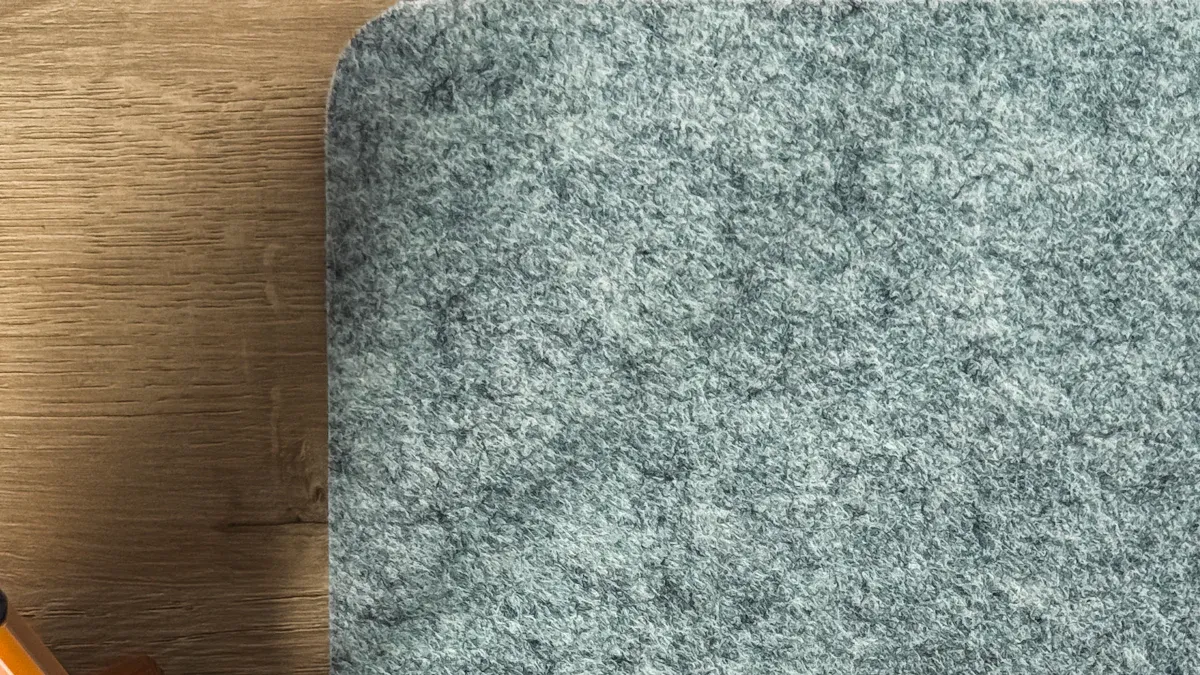
Materials and Build Quality
High-quality office pods rely on strong materials and precise construction. Manufacturers often use aluminum and steel frames for a lighter structure and better sustainability. These metals resist scratches and dents, making them ideal for busy offices. Many pods feature dense MDF panels for sound blocking and thick layers of PET felt made from recycled plastic bottles. Some designs include 100% natural wool and acoustic felt without added dyes, which help reduce noise and improve comfort.
| Material Type | Description and Benefits |
|---|---|
| Aluminum and Steel | Lightweight, durable, and recyclable |
| Recycled PET Fabrics | Easy to clean, long-lasting, and eco-certified |
| Dense MDF | Strong sound blocking and structural support |
| Natural Wool & Felt | Breathable, comfortable, and effective for acoustics |
Build quality affects how long a pod lasts. Sturdy frames, scratch-resistant surfaces, and modular designs help pods handle daily use. Regular cleaning and maintenance, like checking ventilation and inspecting panels, keep pods in top condition. Many manufacturers offer warranties and support, giving offices peace of mind.
Eco-Friendly and Sustainable Options
Sustainability plays a growing role in pod selection. Many companies use recycled metals, reclaimed wood, and organic fabrics to lower their environmental impact. Non-toxic finishes, such as low-VOC paints and natural oils, improve indoor air quality. Eco-friendly insulation, like sheep’s wool or recycled denim, adds comfort while supporting green goals.
- Recycled aluminum and steel reduce energy use.
- Reclaimed wood saves forests and supports responsible forestry.
- Low-VOC paints and adhesives protect air quality.
- Organic fabrics and eco-conscious acoustic panels are biodegradable and safe.
Pods built with these materials balance cost, performance, and environmental benefits. Modern eco-friendly pods offer sleek designs and easy installation, making them a smart choice for offices focused on sustainability.
Customization and Extra Features in Office Booth Pods
Modular Design and Flexibility
Modern office pods use modular designs to support changing office needs. Companies like Allied Modular create pods that move easily and require no permanent construction. Teams can reconfigure these pods to fit new layouts or relocate them as departments grow. Options range from single-person phone booths with soundproofing and LED lighting to huddle pods for small group meetings. Many pods allow customization with acoustic panels and layouts tailored to specific spaces. Providers such as Juniper offer 3D mapping and design consultations, helping clients visualize and plan pod placement. The Zenbooth Solo, for example, fits compact spaces, while the Zenbooth Duo supports collaboration and scales with team size.
Technology Integration
Technology plays a key role in enhancing user experience inside office pods. Many models include soundproofing, adjustable lighting, and climate control to boost comfort and productivity. Built-in Wi-Fi, power outlets, and multimedia screens support both individual work and group meetings. Integration with existing digital systems ensures seamless workflows. Some pods feature IoT automation, allowing users to control lighting and temperature with sensors. Smart climate systems maintain comfort and help save energy. Companies like Your Workpod use motion sensors for ambient lighting and temperature adjustments, making pods more efficient and user-friendly.
Personalization Options
Companies often request personalized features to match their brand and workflow. Popular options include custom sizes, layouts, and finishes. Many organizations choose specific colors, materials, and even add logos or graphics to reflect their identity. Functional upgrades such as enhanced soundproofing, silent ventilation, and ergonomic seating improve comfort. Additional features like storage cabinets, whiteboards, and video conferencing equipment support daily tasks. Flexible door swings, modular configurations, and scalable designs allow pods to adapt as needs change. In-house design teams work closely with clients to create booths that fit unique requirements and office aesthetics.
Office Booth Pod Budget and Value
Upfront Cost vs. Long-Term Benefits
Companies often compare the initial investment in pods to traditional renovations. The upfront cost includes the pod itself, installation, and any custom features. Most pods use a plug-and-play design, which means installation takes less time and causes less disruption than building permanent walls. The table below highlights the differences:
| Aspect | Upfront Costs | Long-Term Benefits |
|---|---|---|
| Initial Investment | Lower than traditional renovations; includes pod and setup | Improved productivity, better focus, and higher meeting quality |
| Installation | Minimal, quick setup | Less downtime, faster return to normal operations |
| Maintenance | Simple cleaning, occasional filter changes | Durable materials, easy relocation, supports changing office needs |
| Traditional Alternatives | High costs for construction and lost productivity | Less flexible, permanent changes, higher disruption |
| Business Impact | N/A | Better employee well-being, flexible planning, future-proofing |
| ROI | N/A | Strong return through cost savings and productivity gains |
Investing in high-quality pods brings long-term advantages. Teams work with fewer distractions, enjoy private meetings, and feel more satisfied at work. Modular pods adapt to new layouts, which saves money on future renovations. Financing options help spread out the initial cost, making pods accessible for many businesses.
Warranty and Support
Leading manufacturers provide strong support to ensure customer satisfaction. Many offer warranty coverage for their pods, which protects against defects and ensures long-term reliability. Professional installation services help set up pods quickly and correctly. Some companies include free office design consultations and expert project management. Customer support teams answer questions and solve problems, making the process smooth from purchase to setup.
- Warranty coverage for peace of mind
- Professional installation and project management
- Free design assistance and fast procurement
- Responsive customer support for ongoing needs
Tip: Always check the warranty terms and available support services before making a purchase. Reliable support adds value and ensures a smooth experience.
Selecting the right Office Booth Pod involves careful review of workspace needs and matching features. Key factors include:
- Available space and pod dimensions
- Ventilation and lighting
- Sound insulation for privacy
- Electrical and connectivity options
- Assembly and mobility
These steps help teams find the best fit for productivity and value.
FAQ
How long does it take to install an office booth pod?
Most office booth pods install within a few hours. Professional teams handle delivery and setup. Users can start using the pod the same day.
Can users customize the interior of an office booth pod?
Yes, many manufacturers offer options for seating, lighting, and finishes. Teams can select features that match their workflow and office style.
What maintenance does an office booth pod require?
Regular cleaning and occasional filter changes keep the pod in top condition. Users should check ventilation and inspect panels for wear.

